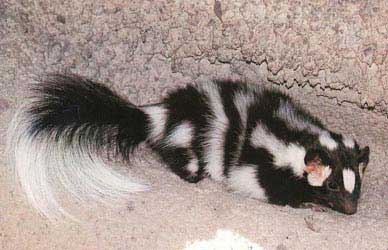Spotted Skunk
Category: North American Mammals

Facts about Spotted Skunk, "Scientific name for Spotted Skunk is Spilogal gracilis". Spotted Skunk is a Spilogale type of animal that comes from the Mephitidae family. The Spotted Skunk is a small animal that inhabits the chaparral biome of southwestern parts of California and in the in between regions of British Colombia and Costa Rica. Usually, the Spotted Skunks prefer the woods, desert, brush land, and rock-strewn terrain. They used to stay away from the dense woodlands and marshlands. The Spotted Skunk breed is capable of living in a range of temperatures. The Spotted Skunk constructs the den from a hole in the ground and lines it by means of leaves. Rarely, the Spotted Skunks live in a hollow tree.
Features of Spotted Skunk
The Spotted Skunk breed is the smallest variety of skunk in its family, with a body length ranging from 21 inches to 25 inches (52.3 to 63.5 cm), including its tail. The Spotted Skunk has a black color body with several white marks, and has a triangular-shaped white color mark on the forehead. All skunks boast a dissimilar pattern from each other, which enables to differentiate the skunk varieties easily.
Usually, the Spotted Skunk breed is taller than most skunks with elongated legs, even though it is not extremely long. Spotted Skunks movements resemble a cat, and it has bigger carnassial teeth than other skunk varieties. The Spotted Skunk use these teeth to cut through the flesh of an animal. Moreover, this animal has pointed claws for digging for larva and climbing trees.
The Spotted Skunk is capable of spraying their predators. They have two anal glands that are packed with musk. When the Spotted Skunk sprays, it jointly compresses the anal glands and the musk emerges from an anal opening. However, there is a method the Spotted Skunk goes through earlier than spraying its opponent. It first gives a caution by stamping the front paws. If the interloper pays no attention, the Spotted Skunk will stand stiff and strut around, and then, stands on its facade paws and waves its back part in the air, and then, it sprays its opponent. The musk can remain in the same place for days. Nearly all animals take the hint and keep away from the Spotted Skunk subsequent to they have been sprayed once. The Spotted Skunk is capable of swimming, but only when their life is in danger.
Diet of Spotted Skunk
Spotted Skunks are omnivorous and they feed on small rodents, berries, fruits, eggs, birds, lizards, insects and their larvae, carrion and snakes. Their diet may differ with the seasons as food accessibility fluctuates.
Reproduction of Spotted Skunk
Usually, the Spotted Skunk mates during October and offers birth in March or April the next year. During the month of March, the testes of the male Spotted Skunks commence to expand and are most enormous by late September. The boost in size is accompanied by a better testosterone manufacture. Likewise, the female Spotted Skunk starts to experience a boost in ovarian activity during March. Spilogale also start to mate in March. Implantation takes place about 14 to 16 days subsequent to mating. Even though litter sizes differ significantly, the regular litter size is about 5.5.
Usually, Spotted skunks can survive up to 10 years in captivity, but in the wild, about 50 % of the Spotted Skunks die after one or two years.
When threatened, the Spotted Skunk will climb a tree to escape or lift its tail and spray the attacker creating a smell that will carry up to a mile.

 Back To Category North American Mammals
Back To Category North American Mammals